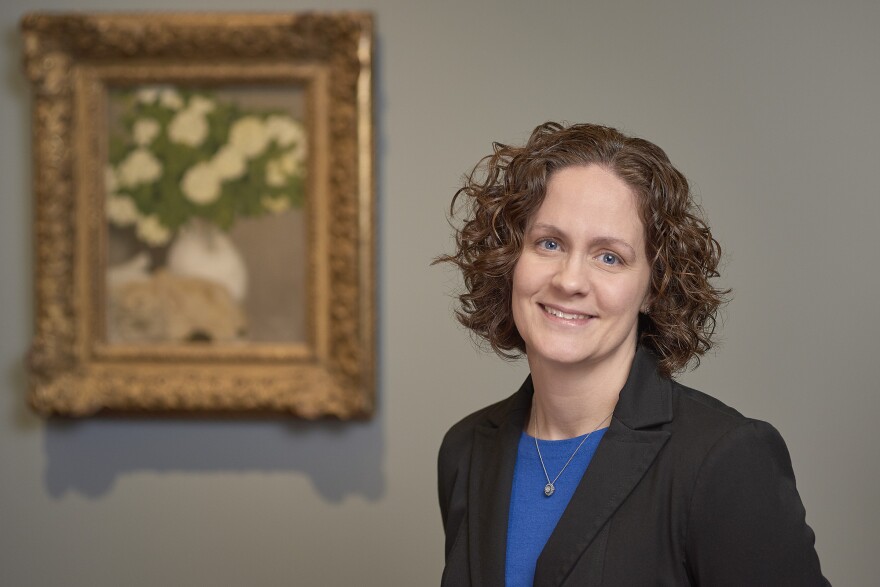You might not know it from looking at her business card, but MacKenzie Mallon is a detective of sorts.
Mallon is The Nelson-Atkins Museum of Art's specialist in provenance, which means she researches the records of ownership for works in the museum's collection.
"We literally have to scour the globe for records into where these objects were, who owned them, when they owned them, where they were and how they changed hands," she says. "Information like that can be in an archive in Austria, or it can be an a record keeping place in L.A., or it could be right here in Kansas City in our own museum."
A current exhibit at the Nelson-Atkins, "Discriminating Thieves: Nazi-Looted Art and Restitution," features some of the fruits of Mallon's labor — four of the seven works in the museum's collection that are known to have been looted by Adolf Hitler's forces during World War II.
How each of the pieces, three paintings and a bust, made their way into the collection varies, and to Mallon, each path is amazing.
"The first work of art that I discovered that had this history, that had been looted by the Nazis," she says, "I think jumped out of my chair."

For example, the route of "Augustus the Strong, Elector of Saxony and King of Poland" took an unexpected turn. The painting is nearly 5 feet tall and features an august-looking man with greying hair who wears armor that's draped with sash and a velvet cape. The half-akimbo man, ostensibly Augustus, gestures toward a burning city in the background.
Mallon had come across a tome of reproduced photo albums that Hitler had used to select works for his Fuhrermuseum, an unrealized museum meant to display the Nazi regime's purchased, stolen and confiscated art.
"I was literally just flipping through the pages thinking, 'Oh wow, this is really interesting,'" she says, "and I stopped on a page that our painting was illustrated on. I recognized it and my first thought was, 'Wait a minute, there's no way.'"
Though the museum had known the painting was acquired by Baron Nathaniel Mayer von Rothschild sometime around the turn of the 20th century, the museum hadn't realized that Nazi forces confiscated it in 1938. It wasn't recovered by Allied forces until May 1945.
"So while we did know the provenance of the picture, we didn't know this little sidestep," Mallon says.
It's unknown how much art the Nazis seized, but "it was certainly in the hundreds of thousands (of pieces)," Mallon says. "By some estimations in the millions."
And it wasn't just paintings or busts.
"Hitler himself was a failed artist and he specialized in watercolor paintings, so his priority was paintings ... (but) they looted everything they could," she says, including sculptures, decorative arts, even household objects.
Mallon says most of the spoils were sold off, kept as a status symbols in the personal collections of German officers or stored for safekeeping in castles and mines throughout German-held land. When the war ended, the art was recovered, categorized and returned to its country of origin, largely thanks to the Allied Monuments, Fine Arts, and Archives program, popularly known as the Monuments Men.

After that, each country was responsible for returning the art to its rightful owners, if they were still alive. In some places, this work is ongoing.
"In France, the Louvre has one gallery that's dedicated to showing art that has not been able to be returned to its rightful owner," Mallon says, "just in the hopes that maybe someone will come into that gallery and recognize something that was once in their family."
In cases like that, Mallon admits, the provenance work is probably never ending. But it's important nonetheless.
"We uncover amazing stories all the time," she says.
"You think about art history is as, you know, the artists and the style and the time in which the artists was creating the works," Mallon adds, "but there's another side to the collection as well. It's where the collection was before it came to us."
'Discriminating Thieves: Nazi-Looted Art and Restitution' is on view until January 2020 in Gallery P10 at The Nelson-Atkins Museum of Art, 4525 Oak St., Kansas City, Missouri 64111. For more information, visit Nelson-Atkins.org.
MacKenzie Mallon spoke with Steve Kraske on a recent episode of KCUR's Up To Date. Hear their entire conversation here.
Luke X. Martin is associate producer of KCUR's Up To Date. Contact him at luke@kcur.org or on Twitter, @lukexmartin.







